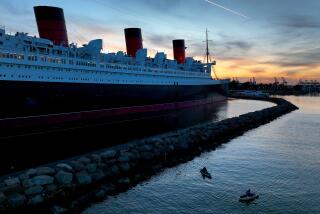Half Moon Now Fully Shipshape
- Share via
An 85-foot, 120-ton replica of the ship Half Moon is poised for its maiden voyage this week down the river Henry Hudson explored in 1609. Project director Andrew Hendricks said the new Half Moon, with a crew of 20, will stop overnight in New York City, then sail two weeks down the Atlantic Coast to a home in Washington, N.C. The ship, which Hendricks called “as historically accurate as it can be,” was built to commemorate the Netherlands’ contributions to America and the trip by Hudson, an English explorer who was working for the Dutch East India Co. when he sailed up what is now the Hudson River. The new ship, unlike the original “Halve Maen,” has an emergency engine and contemporary navigational equipment, Hendricks said, citing Coast Guard regulations and other constraints. The vessel was to have toured some Northeastern ports in summer, but its architect and chief builder, Nicholas Benton, died in a fall from the mast of another ship in June. Hendricks said work was completed from blueprints, but without complete knowledge of the size of some parts or the colors. He said he hoped to cover the cost of the ship, about $1.2 million, by charging admission at a planned visitors center in Washington, N.C.
--In her first public statement since she was hospitalized with heart problems in September, Nobel Prize winner Mother Teresa sent her blessings to the residents of Calcutta to mark the celebration of Durga Puja, a Hindu religious festival. The Roman Catholic nun, described as pale but happy, told a reporter in her hospital room: “I pray for the people of Calcutta while they celebrate the festival. God’s blessing may be with them. I pray for them from this hospital bed.” Mother Teresa had been released the night before from intensive care.
--A University of Illinois art professor and a metalworker teamed up in Champaign, Ill., to erect “The Flag That Will Not Burn”--a 12-foot-tall U.S. banner made from a steel I-beam. “The point of this is to show in a symbolic way that there’s something you can’t destroy, and that’s the American flag,” Prof. Frank Gallo said. The government uproar over flag desecration, Gallo said, inspired the project by him and metalworker Aaron Kurland. But he also said it was a challenge “to see if we can create a sense of fluid movement inside of something that absolutely couldn’t be conceived of as moving.” A bill to make burning the flag a federal crime is nearing final congressional approval. The controversy arose when the Supreme Court struck down a Texas law against flag-burning in June.
More to Read
Sign up for The Wild
We’ll help you find the best places to hike, bike and run, as well as the perfect silent spots for meditation and yoga.
You may occasionally receive promotional content from the Los Angeles Times.






